#19 NW Front Street
Coupeville, Washington
Island County Times / Laundry / Barber / Lorna Doone / McGregor Studio
1906 - Built to house the Island County Times. Previously the Times (formed in 1891) had been in the F.A. Bartlett building across the street (no longer there - see Front Street Grill on this Website.) The site was purchased by W.T. Howard from Lester Still for use by the Times.
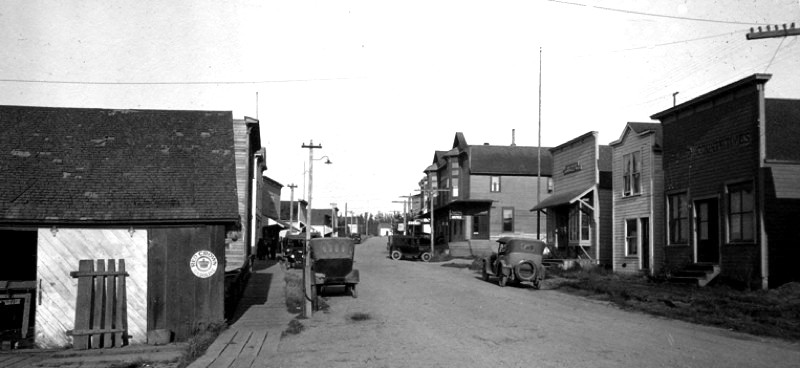
County Times building on the right.
Courtesy: Island County Historical Museum, Coupeville
Quote from "A Particular Friend, PENN'S COVE"
ISLAND COUNTY TIMES
December 31, 1909
"With this issue the Times enters upon its 21st volume, which does not mean the paper is twenty years old. The Times was established in 1891, the first number appearing March 17. The year previous "The Island County Sun" had been established by Chas. W. Angel but there being two bitterly opposed factions, politically and otherwise, a stock company was organized, composed of several of Coupeville's leading citizens and this paper was issued with Mr. Macafee as editor.
"From the preserved files in this office it appears that the manager of the Times kept, from the beginning, copies of his own paper and also of 'The Sun,' which had been in existence fifty weeks, and continued to do so until the two papers were consolidated in 1894. It is a pity that the first 50 issues of 'The Sun' could not also have been preserved as there is no better history of the development of a place than in the doings of its inhabitants, as recorded in the local paper.
"The Island County Times was well edited when it appeared and for a long time afterward, as well as being bright and newsy."
The first editor of the Times, as noted, was Mr. Macafee. The first editor of the consolidated paper was E. G. Earle who in 1900 sold it to D. Carl Pearson.
In 1905 Pearson gave a bill of sale to B. J. White for the Island County Times equipment who seven months later sold it to Edward Howard for $1500. This included all type, cases, presses, tables, stones, paper cutter, etc., also all office furniture, desks, stoves, chairs, subscription lists, books and bills receivable.
Two months later Edward sold it to William. T. Howard for $1600 and the business settled down a bit. W. T. Howard purchased the parcel of land from Lester Still, built the building and published the paper until 1925 when it was sold to Beriah Brown.
The Seattle News of July 15, 1906 refers to Mr. Howard as an old newspaper editor and publisher from Nebraska who ran the paper as a staunch Republican organ, was the official paper of the county and reached nearly every family in Island County. It also refers to The Island County Record published by O. S.Van Olinda which started in January 1906. No copy of that paper is available.
Items from the Island County Times March 22, 1912
Last Tuesday afternoon, at Mrs. Dean's residence, there was organized a club which hereafter will be known as the Ladies of the Round Table. The object of the society will be the improvement of its members along the line of social and political questions. Parliamentary drills and literary and musical programs will be interesting features of the meetings.
Mr. and Mrs. F. J. Pratt arrived on the steamer Calista Tuesday evening and, we understand, will spend the summer here at their home on the west of Ebey's Prairie. They have brought a handsome 38-horse power Cadillac auto with them.
S. M. Fowler, who lives near Fort Casey on a part of the old William Hampton place, recently bought a fine black Percheron stallion which is a beauty.
Captain E. A. Swift, of Seattle, was in town a few hours Tuesday visiting his sister, Mrs. F. P. Race. The Captain had just come to Fort Casey with a boat load of coal, 300 tons.
Wanted - Good home for orphan girl, eleven years old. Adoption if agreeable after reasonable trial. References required.
For sale - A Columbian phonograph, in good shape, with 24 records. Price $15. Can be seen at The Times office.
To trade - A 7-passenger, 50-horse power, auto for land; also one 3-passenger, 20-horse power runabout.
For Sale - Launch nearly new, 26 ft. long and 6 1/2 ft. beam, and 6 h.p. engine. Cost $600. If sold right away will take $250.
This space is bought and paid for by the local Socialist Party of Coupeville: There are 47,000 wage working women in Kentucky who earn only $5.50 a week.
Investigation show that $6.50 is the least that a woman can live decently on. Three thousand women working in a tobacco industry earn only $4.50 a week.
The heads of the tobacco trust are multi-millionaires.
Their gloves are made of women's hides, their champagne is women's sparkling blood. The diamonds they wear flash their light from the eyes of girls trampled into the depths of hell.
For Sale - Second hand piano, or will trade for work horse.
In 1925 the Times was sold to Beriah Brown
Sometime in the 1950s the building was split into two with a Laundry in the west side and Glen Cramer's barbershop in the east side.
*From an interview by Judy Lynn with Leone Argent in 2009
In the newspaper office [Island County Times building] I remember watching them pick up the letters out of those compartments. It was so time consuming. You'd have to watch to see if there were any mistakes. Ever so often I find a mistake in today's paper. That comes from being a schoolteacher.
*From an interview by Judy Lynn with Cleone E. Stoddard Webster in 2010
The Island County Times was on that side of the street. My brother was the editor at one time.
*From an interview by Judy Lynn with Carol Thrailkill, in 2009
On the corner of Front and Alexander was the Sorgenfrei's garage. Island Abstract was where the ice cream store is. The Island County Times was in the building that is now McGregor's. Next was Jim Zylstra's Law Office.
*From an interview by Judy Lynn with Jean Sherman in 2009
Island County Times was in the next building [currently McGregor's]. George Astel was the editor at that time. He was a friend of Pat Wanamaker. I don't know who the editor was after him.
Sometime in the 1970s the building was owned by Don McGaffin and used as a weekend residence. He was well known as a reporter for KING-TV in Seattle.
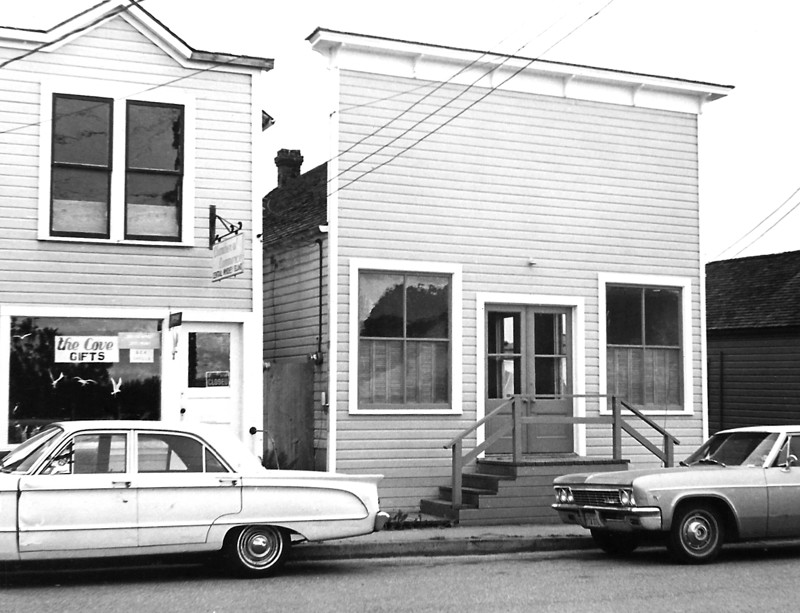
#19 as a residence, 1971
Courtesy: Ebey's Landing Building inventory.
In 1978 The Town Potter was set up by Jan McGregor who also became the owner of the building.
In 1982 Lorna Doone Cate rented the building while Jan McGregor was in Japan and opened Lorna Doone's Attic where she sold seashells, antiques, and collectibles.
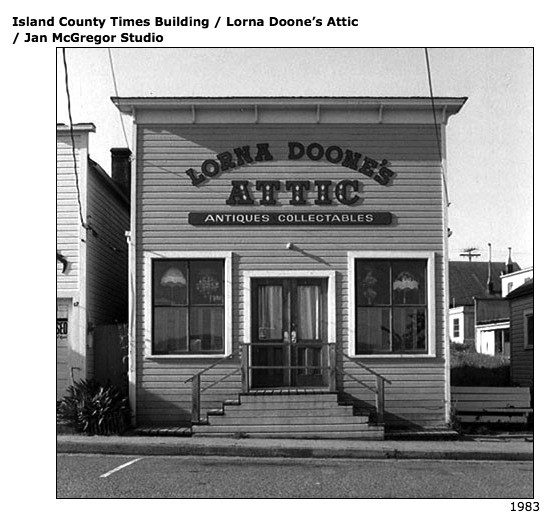
Lorna Doone's Attic
Courtesy: Ebey's Landing Building Inventory.
1987 - The Jan McGregor Studio was opened.
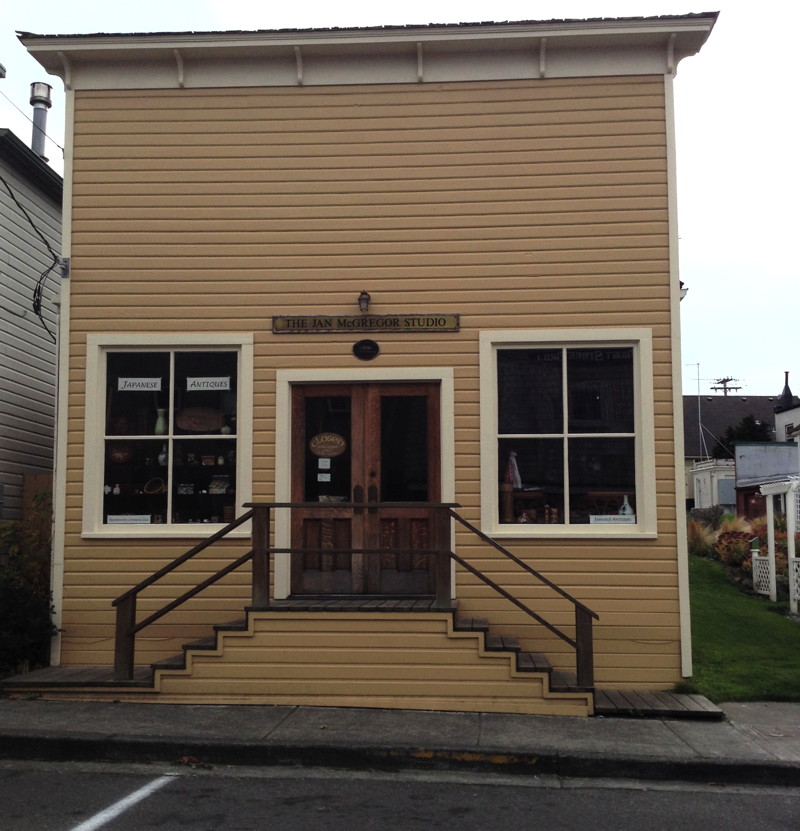
Jan McGregor Studio
Courtesy: Robert Y Elphick, 2013.
1998 - The building was painted by Warner Brothers as part of the agreement for shooting Practical Magic.
*From an interview by Judy Lynn with Jan McGregor in 2009
Judy: How did you come to live in Coupeville?
Jan: My parents lived in Oak Harbor. When I visited them, I fell in love with Coupeville.
Judy: When was that?
Jan: 1976.
This building was for sale. I was a potter…a starving artist…and there was no way I could afford it. I bent on my dad's arm and he was gracious enough to make the down payment. I bought it through Center Isle Realty. Don McGaffin was the owner.
After much haggling with Don I was able to purchase and move in. He had some of his belongings here. With what money I had, I renovated it. It needed a roof and foundation. I built the kiln shed in back and replaced cracked and broken windows. I spent 2 weeks taking nails out of the walls and lead type out of the floors. There is still some lead type in the floors. There was lead type everywhere. [Note: A previous occupant was the Island Times newspaper office.]
Jan: In the process of renovating, as we did one thing, another was revealed. When we jacked the building up for a new foundation many windows broke and the front porch fell away from the building. Rotting timbers under the porch indicated the whole porch needed to be replaced. As we set piers underneath, we found old inkwells. In laying irrigation down the side of building we found more inkwells. Obviously there was a lot of pen and ink being used here in the old days.
Judy: What other history did you discover?
Jan: There were old newspapers from 1906 and a pair of shoes. They are still up in the attic. The floor tells a lot of history. It is original except for 20% in the back. We had to replace that because of powder post beetles. The floor shows all the lead type and holes in the floor where the presses were located.
When I bought the building I lived in the back. I had to move Don McGaffin's things to one side of the room to do some work, then move them to the other side. It was a struggle for a couple of months. I found that old table in between the two buildings. [Note: she pointed out a table that holds obi.] It had set out in the weather for some time. I restored it and it's been part of my display.
There was a barn-board wall that partitioned off the back for my sleeping area. Once I got the building renovated, the gallery was in the front, the clay studio on the east side and my bed, bathroom and kitchen were in the back. I was packed in here like a suitcase. My bed was 4 feet off the floor and everything was stored under it. I lived here for close to 30 years. My life was all work….16 hours a day, 7 days a week.
Judy: Tell me more about Don McGaffin.
Jan: He worked for KING 5 TV doing special reports for KING 5 news. He was very crusty. He had a stroke 15 years ago and came here twice after that to visit. He was disabled, but much more gracious. He was difficult to work with at the time of the sale. He was going through divorce. He didn't want the divorce and he didn't want to sell the building. They used it as a vacation and summer home. At that time there was something to do with town ordinances and having only commercial use of shops on Front Street. I understand they (the McGaffins) sold cookies out of here from time to time. [Note: Don was a friend of Rose and Mahlon Brosseau, owners of the Six Persimmons and also of Joan and Jack McPherson.]
Judy: What did it look like when you first saw it?
Jan: It was full of furniture like a residence. There was a tiny kitchen in the back and a bathroom. There was a barn-board wall around their bedroom.
Probably 2 months after I had moved in and had gotten situated, I began working on the potter's wheel. There was a wood stove on the east wall that was fairly close to the front of the building. The wheel was close to the wood stove. I was getting ready to leave one evening and I heard a crackling sound up at the ceiling. I could see flames through vent holes around the stovepipe. I was so lucky I hadn't left. It was only a few minutes before I was leaving. That was exciting. I was out with the hose by the time the fire department got here. The fireman came in and flooded the attic and downstairs. It was soggy but saved. When it was over there was a 4' square hole in the roof. The chimney must not have been cleaned for some time. I moved the stove back down the wall and it was the only source of heat while I was living here. I cut and split a good portion of the firewood I used. When I moved out I disconnected the wood stove and put in electric heat.
Judy: What else have you done to the building?
Jan: There was an old brick chimney at the back of the building. A cook stove had vented into the chimney. We took the chimney out and rebuilt the portion above the roof to look original but it ends at the roof and is non-functioning.
I have renovated the building from top to bottom at least once…some things twice. The front doors are solid oak. I bought them in Seattle at the time I moved in. They had many layers of paint on them. I spent 5 weeks stripping, sanding and refinishing them.
Judy: What was here before?
Jan: Ancient solid doors that were falling apart…crumbling. I've had the porch rebuilt twice. Once it was the same as the original porch, the second time the carpenter built them to code.
Judy: Rick Castellano from the museum said you were replacing the windows on the front of the building correctly.
Jan: We have renovated all of the wood windows. We took all the old putty off, re-puttied and painted. They are totally restored. It's the second and, in some cases, the third time I've done that. When it was jacked up for the foundation, most of the original glass broke. There is some wavy glass left.
Some of the charm of the building is that it's all fir…nearly petrified. The wood is so hard you can hardly get a nail or screw into it.
Something else I did…The original building had no supports in the ceiling. The attic wasn't strong enough for storage. A friend put supports in the attic so it could be used for storage. Later I replaced the original 2 x 4 posts in the center of the gallery with 6 x 6's and 8 x 8 beams. I put them in from the ground. Those supports are in the shape of a tori, the gate to a Shinto shrine.
I had the shed built in the back for a kiln shed. There had been a 4 x 4 garden shed but I had that removed and built a 12 x 12 room and replicated the roofline of the main building. It is now used for retail display. You can access it out the back door.
I built the garden in the back. There was nothing there except the Hawthorne tree. When I had more time to tend it, it was glorious. It is always needing work at this point.
Judy: Tell me about your pottery.
Jan: I have been a professional potter since 1973, working primarily with stoneware. I had always wanted to work with porcelain and wanted to study with the best porcelain potters available. In 1982 I rented out the shop. I went to Japan with an introduction from Herbert Sanders (pottery professor at San Jose State), to the National Treasure Kondo Yuzo. Kondo sensei arranged for me to study under Koyama Kihei who was the assistant to the National Treasure, Tomimoto Kenkichi. I studied porcelain techniques in general and specifically the inlaid cobalt technique.
I returned from Japan in 1984 and began implementing the techniques I acquired in Japan. I used to think that it took 20 years to become a master potter. By the time I reached that mark, I no longer believed in masters. You can never learn it all!
Judy: Tell me about the Washi Boxes?
Jan: I needed something to do in the summertime when the shop was too busy to work with clay. I had become familiar with chabako, which are large wooden boxes used for shipping and storing green tea. I thought it would be a great design for tea boxes for the kitchen. I began making small boxes covered with handmade "washi" paper from Japan. This washi paper is from the bark of the mulberry tree. The beautiful designs are screen printed, once for each color. The boxes were very popular in the shop.
Judy: Where did you do this work?
Jan: I did it right here on this desk. I love fine work. It's mindless meditation.
I soon became obsessed with building the Japanese farmhouse. I realized the Washi Boxes were the perfect vehicle to finance that project. I found a family in Japan to take over the handcrafting of the Washi Boxes. I became a member of The Museum Association and began wholesaling the boxes, and other items I created, to museums all over the country. They were even in the Smithsonian gift shop.
I created a washi egg ornament for the wholesale line. I created a washi paper covering, which I cut 120 times, so that the paper would wrap around the paper mache egg without distorting the patterns. I took them to one of the museum shows expecting to take orders for a few hundred. I took orders for 6,000 eggs! In addition to museum shops, they were to go in half a dozen museum catalogues. I had 4 months to get them done before the holidays, so I had a dye made to cut the paper. I worked 16-hour days, 7 days a week, covering eggs by hand and glazing them. That winter my car broke down, so I took my "egg money" to Seattle and came come with a new Honda Accord.
I currently wholesale 3 sizes of Washi Boxes, jewelry boxes, music boxes, egg ornaments and origami note cards. These are all things I designed and created to finance building the farmhouse. The antique business has financed the new studio, kiln shed and Japanese garden.
Judy: Are you still selling through museums?
Jan: Yes, but I'm going to have to start acting my age and begin slowing down. I'm about ready to discontinue the wholesale business.
Judy: When did you add furniture to the shop?
Jan: As soon as I moved into the loft of the farmhouse, I went to Japan and purchased a 20-foot container of antiques. I had sleepless nights not knowing if that business was going to fly. I knew I would eventually get my investment back. It sold in 3 months! The second 20-foot container sold in another 3 months. Then I began bringing over two 40-foot containers a year. That went well until the first day of Mr. Bush's war. I brought a 40-foot container a year ago and still have part of it. I have a couple of storage places. One is a warehouse in Oak Harbor. We wash and oil the tansu [Japanese chests] there. They are very dirty when I get them. It's a pleasure to see them go from ugly ducklings to swans.
Judy: Tell me about the beautiful clothing you have for sale.
Jan: I've wanted to design clothing since I was in high school. A year and a half ago one of my long-standing customers came in. I had on a pair of pants I had made and she complimented me on them. I told her of my ambition to design clothing. She told me she had been a professional seamstress. She said, "I need something to do. Let's do this." I purchase Kimono and kimono fabric from Japan and we are making American style clothing from the 14'" wide fabric that all kimono are made from.
Judy: Are they new or used kimonos?
Jan: Half are made from used kimono and half are made from kimono bolt fabric. The used kimono are in mint condition. I am able to find vintage bolts of cotton and silk. I am still going to Japan once or twice a year, depending on need and demand, and I buy through dealers. We are both designing. She is doing all the sewing and we both take apart the kimono. She lives by the Canadian border and is looking for a place here.
Judy: Did you continue going to Japan to study pottery?
Jan: I'm implementing the techniques that I studied intensively for 2 years. Now I go back to visit my Sensei and buy antiques, textiles, etc. for the shop.
Judy: I remember watching you work on your pottery years ago, layering thin pieces so carefully. What do you call that process?
Jan: It's a polychrome slip overlay process. I was spending about 6 weeks on each piece, and was in a vegetative state when I was finished. It was deep meditation.
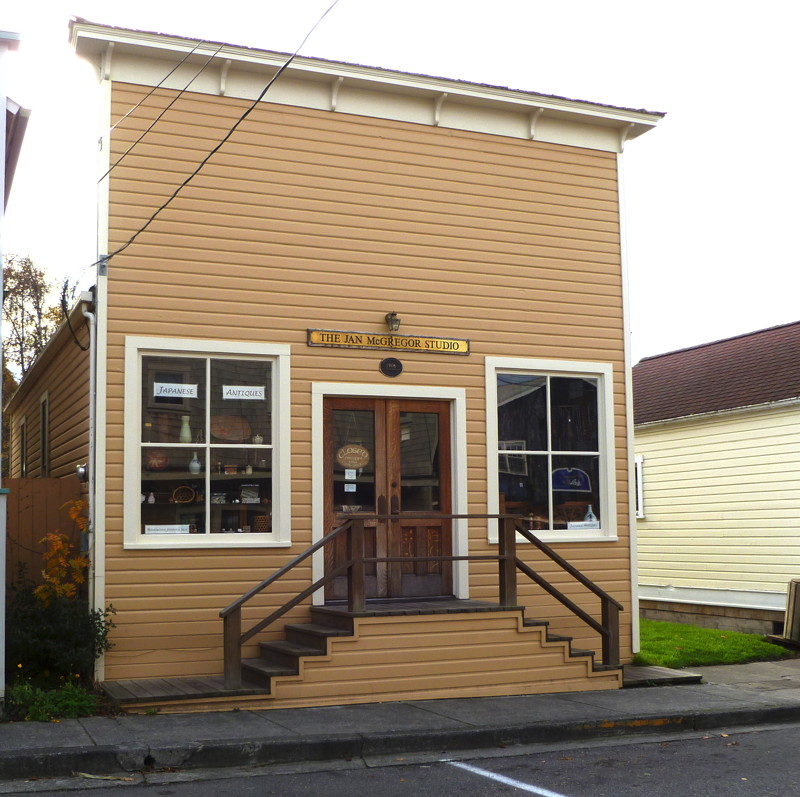
Jan McGregor Studio
Courtesy: Robert Y Elphick, 2013.
* All the interviews are extracted from the Judy Lynn's Oral History Project. Judy Lynn interviewed everyone she could find who had any memories of the history of Front Street. For more information on the project contact the Whidbey Island Historical Musem, Coupeville.
The e-book Front Street, Coupeville - An Oral History by Judy Lynn contains all the interviews. It can be purchased for $9.99 at Amazon.com for Kindle application or device or from the Apple Store for iBooks applications. Proceeds go to the Island County Historical Society.


